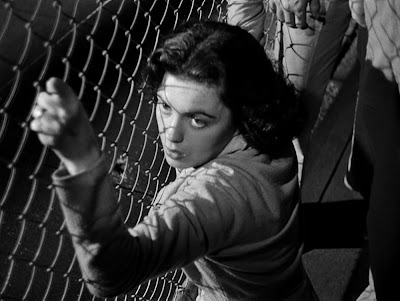![]()
 on 10/27/2024, 7:06 pm
on 10/27/2024, 7:06 pm
The film clearly inspired Mark Fertig, who named his blog after it. But he never wrote about it (perhaps not wanting to call attention to his appropriation of the title...or maybe because he didn't want to have to take after the film--which has as many problems as its female protagonist).
But we can't leave 1950 without tackling it, so I've substituted an IMDB review which I am surmising might approach the tone and writing style that has been emerging from Mark's blog. It should have been included, if only for name-check value alone...and for the fact that despite its many surreal flaws, it remains preposterously entertaining.
Faith Domergue, who plays Margo Lannington, the femme fatale in Where Danger Lives, had an intermittent affair with the film's producer Howard Hughes, beginning in 1942 when she graduated from high school. She was eventually signed to a three-picture deal with RKO and later achieved a measure of fame by starring in B sci-fi pictures in the 50s (among them Cult of the Cobra). The protagonist here is Dr. Jeff Cameron, played by Robert Mitchum, cast against type as a doctor working in a hospital and on the verge of going into private practice.

Where Danger Lives suffers from implausibility practically from the beginning. We can see right away that Mitchum's character is thinly drawn: he loves children and is going out with a nurse at the hospital (director John Farrow's wife, the still-luminous Maureen O'Sullivan). He's primed for a safe, solid, exemplary life. As things unfold with a kind of foggy delirium before our eyes, we can't avoid asking ourselves: why he would fall so easily for Margo, his patient whom he treats as a suicide victim? Given how his character has been set up, wouldn't that have been unethical for him to immediately start dating her since she was his patient? And shouldn't he have noticed the red flag going up when she disappears from the hospital after treatment and then sends him a note to meet her at her home?
Nonetheless, the good doctor inexplicably falls for this obviously unstable woman simply on the basis of her looks, without knowing anything about her. After some perfunctory romancing at a proto-tiki restaurant, Cameron is about to discover that the exotic girl who looks so good in a sarong has a secret that will upend his life (and do much the same to the film itself.)

But first we have the film's best scene, a bizarre story switcheroo that would fuel many a subsequent TV noir in the future. When Margo brings Cameron home to meet her father, Frederick Lannington (Claude Rains), he is informed (with Rains' matchlessly bemused, eye-rolling weariness) that Margo is not his daughter, but his wife! Impulse control suddenly flatlines, which leads to a physical altercation between Cameron (already tipsy from drinking too much at a restaurant) and Frederick, who falls and hits his head on the floor. In less than six minutes, Rains goes from snarlingly sardonic to glassy-eyed and ready for his close-up in the morgue. (Later we learn that Cameron's blow was not lethal: it has only knocked Lannington unconscious. Margo, improvising as only a deranged hottie can do when the scriptwriters were as intoxicated as their lead character, smothers him with a pillow while the befuddled Cameron is distracted.)
During the fight, Lannington had struck Cameron with a poker causing a severe concussion--leaving Cameron punch drunk for the rest of the film. Margo is able to take advantage of Cameron, whose lust has been compounded with interest and is clearly not in possession of his faculties. Addled and vulnerable, he agrees to her hare-brained plan to flee--for Mexico.
The fate of the newly-minted fugitives is then depicted in a series of odd scenes created in an attempt to mask the wafer-thin nature of the story:
--The couple deciding to nix the idea of taking a plane when they spot cops at the airport;
--The trade-in of Margo's convertible for an old pickup truck to throw the cops off the trail;
--The couple being forced to get married after Cameron fails to wear a fake beard during a hick town's "Wild West Whiskers Week";
--Margo selling her valuable necklace to obtain cash which they pay to a smuggler, who arranges for them to get to Mexico in a truck which is part of a circus troupe.
Meanwhile, Cameron survives Margo's attempt to smother him to death and laughably crawls his way out of the place where the unlikely duo were waiting to be picked up. Cameron manages to stop Margo from escaping to Mexico but he's almost killed when she fires a pistol at him. She's not really a femme fatale, however--just a wildly unpredictable nutcase whose feelings and actions suggest a psyche as twisted as a runaway tornado. Her lack of impulse control is fully on display at film's end, when her fugue state creates a convenient coda (death by cop) that also conveniently provides a belated alibi for Cameron.

Director Farrow and photographer Nicholas Musuraca give the film a tough, exceptionally crisp visual edge, but despite their expert efforts its hellishness only descends mid-way, stalling at around circle number five--the region reserved for chumps and trollops who are caught in the bathetic brimstone of a derivative, implausible script.
Responses